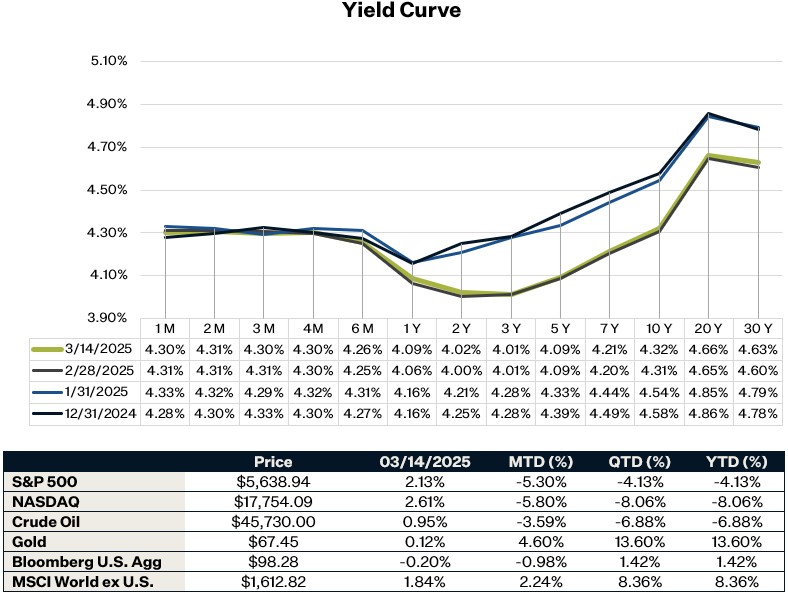
Market Update
The S&P 500 officially entered correction territory on Thursday, as uncertainty about the policy forward from the new administration has been the key to the shift lower in growth expectations and weakness in risk assets. The assumption that this administration will be pro-growth and equity and dollar supportive is being questioned. On Friday, however, the market reversed course and posted strong gains of 2.13% - most likely due to investors trying to take advantage of the pullback and the drop in valuation multiples. So far in 2025 the performance among equity markets is quite different compared to the past 10 years, when the U.S. consistently delivered greater returns compared to others due to stronger profit growth. The recent shift has been for a few reasons: 1) U.S. economic growth outlook is weakening while the growth outlook in certain international regions, especially in Europe is improving, 2) investors fear that tariffs may negatively impact the U.S. economy more than others, and 3) the S&P 500’s heavy weighting to large cap tech (especially the “Magnificent 7”) is hurting the index as those companies are underperforming the rest of the market. We expect more volatility and uncertainty to continue in the near-term as investors wait and see if more policies are introduced, most notably the reciprocal tariffs that are supposed to take effect on April 2nd. This week the Fed has their FOMC meeting on Wednesday, with the market expecting them to keep rates on hold.
Consumer Sentiment
US consumer sentiment fell to its lowest level since November 2022, with the University of Michigan's preliminary March index dropping to 57.9 from 64.7 in February. Long-term inflation expectations surged by the most since 1993, with consumers anticipating 3.9% annual price increases over the next 5-10 years, the highest in over three decades. The decline in sentiment is largely driven by growing concerns over tariffs. While inflation eased last month, uncertainty over economic policies and potential cost increases from tariffs have made it harder for consumers to plan for the future. Short term inflation expectations rose to 4.9% the highest since 2022, while consumer’s financial expectations hit a record low. Consumers from all three political affiliations agree that the outlook has weakened since February. Future expectations declined among Republicans (-10%), Independents (-12%), and Democrats (-24%) in March.
February Inflation
February CPI inflation came in slightly below estimates, with headline CPI rising 0.2% month-over-month (MoM) (2.8% year-over-year “YoY”) and Core CPI up 0.2% MoM (3.1% YoY)—the lowest core reading in 12 months. The slower inflation pace was driven in part by declines in new car prices (-0.1% MoM) and gasoline (-1% MoM). Categories that previously pushed core CPI higher, such as airfares (-4% MoM) and car insurance (+0.3% MoM, adding 8bps last month), reversed in February, collectively subtracting 4bps from inflation. Additionally, services inflation cooled, rising just 0.2% MoM after posting its largest increase in a year the previous month. Shelter inflation remained elevated at 4.2% YoY, though its 0.3% MoM rise was in line with expectations and marked the smallest annual increase since December 2021. Despite this encouraging inflation data, tariffs pose a lingering risk to price pressures. So far, goods prices have risen just 0.2% MoM, with furnishings, toys, and televisions showing little impact from last month’s tariffs on Chinese imports.
Labor Market
The latest JOLTS report showed improved labor market conditions for the month of January. Job openings rose 7.74 million which caused the opening rate to rise from 4.5% to 4.6%. The hires rate remained steady at 3.4% and the quits rate actually increased from 1.9% to 2.1%. Additionally, the layoffs rate declined from 1.1% to 1%. Looking at more recent data from Indeed and LinkUp show that job openings have declined slightly since January however. Jobless claims remained steady for the week ending March 8th, and continuing claims fell from 1.897 million to 1.87 million. The labor market is likely to remain stable in the near-term unless we see a sharp drop in consumer health and spending.
Sources:
https://www.bloomberg.com/news/articles/2025-03-14/fed-2025-interest-rates-economists-say-two-cuts-starting-in- september?srnd=homepage-americas
https://www.bls.gov/news.release/cpi.nr0.html
https://www.dol.gov/ui/data.pdf
Reinhart, A. (2025) US: Lagged JOLTS data showed improving labor conditions. JP Morgan.


